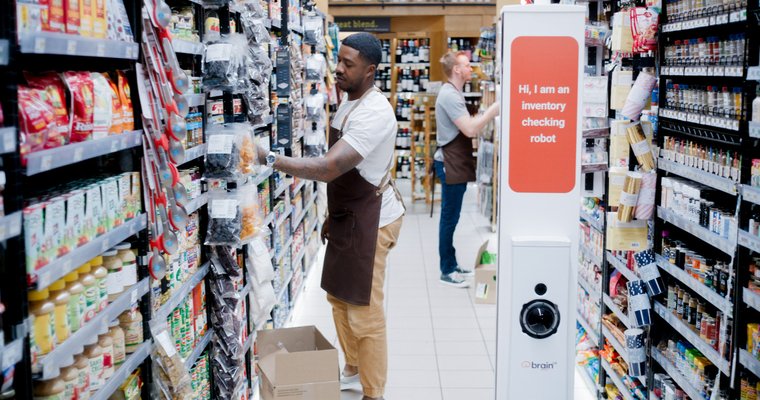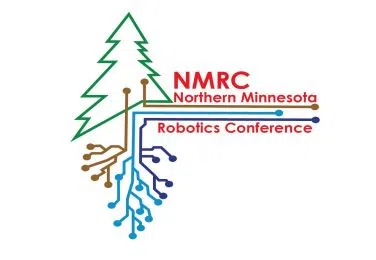Robots in retail: Automation revolution in play

Autonomous robots deployed in retail cover millions of square meters a week with inventory scanning robots capturing 26 million images a day. Brain Corp CEO David Pinn shares what he envisions to come.
Shown is a Brain Corp-powered Dane AIR device. Photo: Brain Corp
The day of The Jetsons has not only arrived but is being propelled forward as retailers tap robotics and automation not only to save money and put workers on more valuable tasks but also to enhance the retail customer experience.
At the end of 2023, Amazon announced it was testing Digit, a bipedal robot, in a collaborative warehouse work environment.
Newegg Commerce Inc., an e-commerce technology product retailer, has deployed the Geek+ shelf-to-person mobile picking systems, which run on autonomous mobile robots, in the company’s Ontario, California warehouse.
Stine LLC, a hardware retail chain, is rolling out in-store robotics within stores to detect out-of-stock products and improve price tag accuracy.
Stop & Shop is expanding the use of Marty the Robot at more than 300 of the grocer’s Northeast stores.
Robots running everywhere
On the provider side, Brain Corp, an autonomous tech company launched in 2009, has over 30,000 robots in play globally running on its BrainOS software.
In 2018 Brain Corp began collaborating with Walmart and started by deploying its autonomous scrubber robots in a few hundred stores. That then led to a full nationwide deployment across all Walmart stores.
In 2022 Sam’s Club deployed the company’s robotic inventory scanner across 600 club locations.
The list doesn’t end there, as Kroger and Schnucks are also using the company’s robots to improve productivity and ease worker shortages.
To get a deeper perspective on retail and robotics adoption RetailCustomerExperience reached out to Brain Corp CEO David Pinn in an email interview. Pinn shared insights on trends and his predictions on where retailers will be placing automation bets in the future.
Retail automation: Trends and predictions
Q: How would you describe where autonomous robots are within the retail segment at this point?
A. It’s an exciting time, but autonomous retail robots are still in the early stages. To use a baseball analogy, I like to say we are just at the bottom of the first inning. However, their potential is already proven. We have successfully deployed robots at a large scale in several retailers, including seven of the ten largest food and grocery retailers in the world. To date, we have deployed over 35,000 robots in commercial public spaces, with a large portion in retail stores.
Many of those robots are autonomous floor scrubbers, robots that take on the tedious and time-consuming task of cleaning store floors. For instance, one of our typical retail customers has deployed autonomous floor scrubbers in 245 stores. Each robot saves approximately 2.5 hours of labor per day per store, representing more than 223,000 hours of productivity annually that can be redirected to higher value tasks.
And robots can do even more. They add automation and intelligence to a retailer’s core competency of managing inventory. We are deploying inventory scanning robots to help retailers detect out-of-stocks items, inaccurate price tags, and misplaced products.
This translates into improved speed to replenishment, enhanced pricing and promotional compliance, and more efficient and accurate online order fulfillment. Inventory scanning robots reduce revenue loss and improve customer satisfaction. To give you a sense for the scale of this solution: our inventory scanning robots captured almost 8 billion shelf images last year alone.
While it’s still early in the game, autonomous robots are making significant impact at some of the world’s largest retailers, improving their efficiency and accuracy in essential operations.
Q: Is there a primary use or trend retailers are using the robots for, or is it more scattered in terms of need?
A: The primary motivation is relieving human workers from dull and repetitive tasks so that they can spend time on more meaningful work, like providing friendly customer service. Today retailers are focused on automating two in-store tasks: floor care and inventory management.
In the case of inventory management, prior to introducing robots, retailers relied on their teams to roam every aisle in their stores and manually identify issues among tens of thousands of different SKUs. This process is slow and challenging to perform with high accuracy. Common practices of hand-scanning shelves or wanding RFID tags are also time-consuming, error-prone, and unenjoyable.
Instead of asking store associates to hunt for problems, we provide them with tools to help them do their jobs better. Our inventory scanning robots relentlessly identify what needs to be fixed so store associates can efficiently correct the issues. Providing teams with tools for success helps them achieve more and enjoy more fulfilling work.
Q: Where do you see top retailers using automation and robotics when it comes to improving store operations?
A: Improving store operations is a central goal of automation and robotics. The intent is to get essential tasks done faster and with higher productivity.
When autonomous robots clean the floors, team members are freed to spend more time on store maintenance. The robots also create detailed maps that show that the right areas are getting cleaned with the right frequency.
When autonomous robots help with inventory management, team members spend less time scanning product displays and more time serving customers in valuable ways. Using computer vision and GenAI to analyze the data collected by robots, we provide accurate, timely intelligence that helps store associates keep the right product on the right shelf at the right price.
Supply chain excellence begins in the store. The benefits of adding intelligence and automation to the store propagate upstream, throughout the entire supply chain. Data collected from store shelves are invaluable for predicting market trends, seasonal changes, and customer preferences. When supply chain operations sync with real-time shelf data, retailers can anticipate demand, manage inventory better, streamline logistics, and boost profits.
Q: What role do autonomous robots play in the retail customer experience?
A: When they help stores work better, robots have direct and indirect benefits on customer experience.
First, shoppers prefer clean and attractive stores. Maintaining cleanliness throughout a store creates a welcoming environment that customers want to shop in. Autonomous floor care robots consistently provide increased levels of cleanliness that shoppers can see and feel.
Second, a critical aspect of customer service is shoppers’ ability to find what they want, where they want, and when they want. Autonomous inventory scanning robots monitor product availability, placement, promotions, and price. This highly accurate data supports timely replenishment that reduces out-of-stock disappointments and ensures correct pricing.
Third, robots improve customer service. Automating routine and time-consuming tasks frees employees to focus on serving customers and solving customers’ problems, elevating the shopper’s experience. Stores that deploy robots can provide a differentiated customer experience in a competitive market landscape.
Q: Any big predictions or expectations of where autonomous robotics will be in 5 years or 10 years?
A: Autonomous robots will be in more places doing more tasks.
Two key factors drive this trend. First, declining birth rates and an aging population increase the need for automation. Second, advancements in AI technology will continue unlocking the capability to automate increasingly complex tasks.
As an example, GenAI techniques are being applied in research labs to solve robotic manipulation problems, like picking up any product from a shipping carton and placing it on a shelf. These advancements will allow robots to not only collect shelf data, but also restock shelves and arrange items properly.
While this technology is not ready for commercialization yet, we’re excited about helping our retail customers today with autonomy solutions that are already proven and scalable. So, my message to all is, “Let’s start collaborating today, so that in five-to-10 years we’re not just starting to automate, but rather, we’re building upon our proven successes in automation.”



